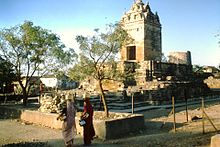ଗୋପ ମନ୍ଦିର
| ଗୋପ ମନ୍ଦିର | |
|---|---|
ગોપનું મંદિર | |
 ଷଷ୍ଠ ଶତାବ୍ଦୀର ସୂର୍ଯ୍ୟ ମନ୍ଦିର | |
| Religion | |
| ଅନୁବନ୍ଧଗୁଡ଼ିକ | ହିନ୍ଦୁ |
| District | ଜାମ ନଗର ଜିଲ୍ଲା |
| ଦେବାଦେବୀ | ସୂର୍ଯ୍ୟ, ସ୍କନ୍ଧ, ଅନ୍ୟାନ୍ୟ[୧] |
| Location | |
| ସ୍ଥାନ | ଜିନାଭରି ଗ୍ରାମ,ଜାମଯୋଧପୁର ତାଲୁକା |
| State | ଗୁଜରାଟ |
| Country | ଭାରତ |
| ଭୌଗଳିକ ଅବସ୍ଥିତି | 22°1′43″N 69°55′44″E / 22.02861°N 69.92889°E |
| Architecture | |
| Style | ହିନ୍ଦୁ ମନ୍ଦିର ସ୍ଥାପତ୍ୟ |
| Completed | 6th century CE[୨] |
ଗୋପ ମନ୍ଦିର ଏକ ସୂର୍ଯ୍ୟ ମନ୍ଦିର ଯାହା ଭାରତର ଗୁଜରାଟ ପ୍ରଦେଶସ୍ଥିତ ଜାମନଗର ଜିଲ୍ଲାର ଜିନଭାରି ଗ୍ରାମରେ (ଜାମଯୋଧପୁର ତାଲୁକା) ଅବସ୍ଥିତ । ଗୁଜରାଟରେ ଏହା ଏକ ଷଷ୍ଠ ଶତାବ୍ଦୀରେ ନିର୍ମିତ ଏକ ପ୍ରସ୍ତର ନିର୍ମିତ ହିନ୍ଦୁ ମନ୍ଦିର ।[୨][୩] ମୂଳ ମନ୍ଦିର ନଷ୍ଟ ହୋଇଥିଲେ ମଧ୍ୟ ଆଂଶିକ ଭାବରେ ତିଷ୍ଠି ରହିଛି ।[୨] ମନ୍ଦିରର ଉଚ୍ଚତା ୨୩ ଫୁଟ । ଏକ ମୁକୁଟ ଭଳି ଛାତ ତଳେ ଏକ ଗବାକ୍ଷ ଆକାର ଭଳି ସଜା ହୋଇଛି ।
ସ୍ଥାନ
[ସମ୍ପାଦନା]ବରଦା ପର୍ବତର ଗୋପ ପାହାଡ଼ର ଦକ୍ଷିଣ-ପଶ୍ଚିମ ଦିଗରେ ଭର୍ତୁ ନଦୀ କୂଳରେ ଏହା ଅବସ୍ଥିତ । ଜିନାଭରି ଗ୍ରାମକୁ ଜୁନା ବା ନନା ଗୋପ ମଧ୍ୟ କୁହାଯାଏ ଓ ଏହା ଗୋପ ଗ୍ରାମର ପୂର୍ବ ଦିଗରେ ଅବସ୍ଥିତ । ଘୁମାଳୀର ଉତ୍ତର ଦିଗରେ ଏକ ପାହାଡ଼ ଉପରେ ଏହା ବିଦ୍ୟମାନ ।[୪][୩]
ଇତିହାସ
[ସମ୍ପାଦନା]ସୌରାଷ୍ଟ୍ରର ବଞ୍ଚି ରହିଥିବା ମନ୍ଦିର ମଧ୍ୟରୁ ଏହା ଗୋଟିଏ ।[୩][୪] ୧୮୭୬ ମସିହାରେ ବରଜେସ ହିସାବ କରି ଦେଖିଥିଲେ, ଏହା ଷଷ୍ଠ ଶତାବ୍ଦୀ ପରେ ତିଆରି ହୋଇନି ।[୪] ସଂକଳିଆ ମତରେ ଏହା ପଞ୍ଚମ ଶତାବ୍ଦୀରେ ତିଆରି ହୋଇଛି କିନ୍ତୁ ଜୁନାଗଡ଼ ବୌଦ୍ଧ ଗୁମ୍ଫା ପୂର୍ବରୁ ନୁହେଁ ।[୫] ଏହାର ସମୟ ସାଧାରଣ ଭାବରେ ଷଷ୍ଠ ଶତାବ୍ଦୀରେ ହୋଇଥିବା ମନେ ହୁଏ (575-600 CE) । ).[୨][୬]


ଆଧାର
[ସମ୍ପାଦନା]- ↑ Sara L. Schastok (1985). The Śāmalājī Sculptures and 6th Century Art in Western India. BRILL Academic. pp. 75 with footnotes. ISBN 90-04-06941-0.
- ↑ ୨.୦ ୨.୧ ୨.୨ ୨.୩ Ulrich Wiesner (1978). Nepalese Temple Architecture: Its Characteristics and Its Relations to Indian Development. BRILL Academic. pp. 47–48 with footnotes. ISBN 90-04-05666-1.
- ↑ ୩.୦ ୩.୧ ୩.୨ Susan Verma Mishra; Himanshu Prabha Ray (5 August 2016). The Archaeology of Sacred Spaces: The Temple in Western India, 2nd Century BCE–8th Century CE. Routledge. pp. 108–109. ISBN 978-1-317-19374-6.; Quote: "The earliest image in the region can be dated to the fourth century CE and a worn out figure at the temple of Gop dates to between 525 and 550 CE".
- ↑ ୪.୦ ୪.୧ ୪.୨ James Burgess (1876). Report on the Antiquities of Kutch & Kathiawar: Being the Result of the Second Season's Operations of the Archaeological Survey of Western India, 1874-1875. London: India Museum. p. 187. Retrieved 27 August 2016.
Alt URL Archived 2016-08-29 at the Wayback Machine. This article incorporates text from this source, which is in the public domain.
This article incorporates text from this source, which is in the public domain. - ↑ Hasmukh Dhirajlal Sankalia (1941). The Archaeology of Gujarat: Including Kathiawar. Natwarlal & Company. pp. 55–59.[permanent dead link] Alt URL Archived 2017-08-03 at the Wayback Machine.
- ↑ Jutta Jain-Neubauer (1 January 1981). The Stepwells of Gujarat: In Art-historical Perspective. Abhinav Publications. p. 14. ISBN 978-0-391-02284-3.





